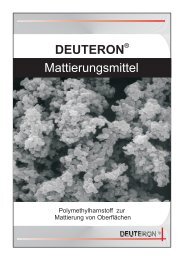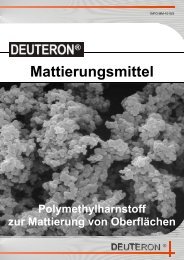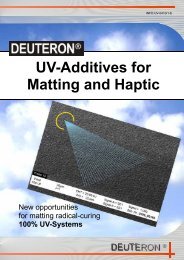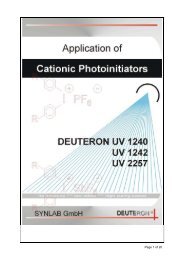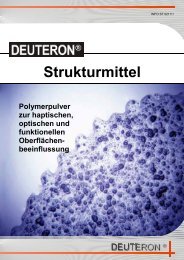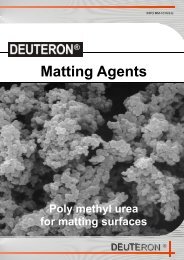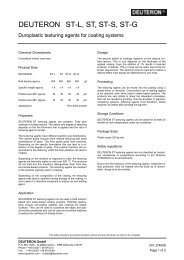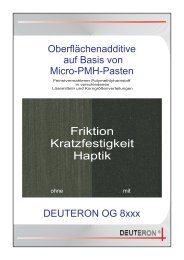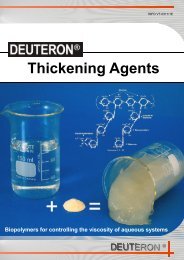Wax Additives - Deuteron GmbH
Wax Additives - Deuteron GmbH
Wax Additives - Deuteron GmbH
You also want an ePaper? Increase the reach of your titles
YUMPU automatically turns print PDFs into web optimized ePapers that Google loves.
<strong>Wax</strong> <strong>Additives</strong><br />
Improvement of the haptical, optical<br />
and mechanical properties<br />
INFO WA-0211/1E
<strong>Wax</strong> raw materials can be<br />
split into the following<br />
groups:<br />
<strong>Wax</strong>es<br />
Natural waxes<br />
Semi-synthetic<br />
waxes<br />
Synthetic<br />
waxes<br />
The use of waxes in coatings introduces release and slip<br />
properties. <strong>Wax</strong>es give the film surface a lower surface adhesion<br />
and often results in a fine, uniform surface characteristic. The<br />
main property improvements are:<br />
Release properties<br />
Dirt-repellent properties<br />
Anti-blocking effect / stackability<br />
Scratch resistance<br />
Reduction of the static and dynamic friction<br />
Surface smoothness<br />
Haptic properties<br />
Oxygen inhibition<br />
Matting<br />
Sanding properties<br />
Anti-sedimentation<br />
<strong>Wax</strong> as additive in coatings<br />
Carnauba wax<br />
Bee‘s wax<br />
Montan wax<br />
Paraffin<br />
Modified montan wax<br />
Amide wax<br />
Polyethylene wax<br />
Polypropylene wax<br />
Fischer-Tropsch-paraffin<br />
Preparation<br />
via<br />
emulsification<br />
wet milling<br />
micronising<br />
precipitation<br />
<strong>Wax</strong> additives offered by DEUTERON<br />
<strong>GmbH</strong> are shown in GREEN.<br />
The form used for coatings,<br />
is normally ca. 1-25 µm in size.<br />
DEUTERON-WAX A Micronised polyamide wax with excellent<br />
resistance to heat and chemicals and high hardness. Matting<br />
effect and improved sanding properties.<br />
DEUTERON-WAX MPO Non-polar micronised polyolefin wax with<br />
a good matting effect. It increases the mechanical and chemical<br />
resistance of the coating surface and reduces the sedimentation<br />
of pigments and fillers in pigmented systems.<br />
DEUTERON-WAX PP Micronised polypropylene wax with a wide<br />
range of uses.<br />
DEUTERON-WAX TF Micronised PTFE modified polyolefin wax.<br />
Polytetrafluoroethylene has the lowest friction coefficient of all<br />
solid substances and hence has the highest slip and anti-blocking<br />
values in organic coatings.<br />
DEUTERON AP348 Polyethylene wax with high hardness in the<br />
form of prills for incorporation via the melts, for example for<br />
powder coatings: It reduces the gloss and improves the levelling.<br />
DEUTERON UV RS20 Dispersion of high molecular weight PE<br />
waxes in DPGDA for altering the surface smoothness in radical<br />
curing UV systems. Moderate matting effect.<br />
DEUTERON OG 250 Stabilised, aqueous paraffin dispersion of<br />
low melting point as an additive for manufacturing water-based<br />
soft-feel coatings. The product has a strong hydrophobic effect.<br />
DEUTERON OG 330 Aqueous dispersion of a polyethylene wax,<br />
PTFE modified. Improves surface smoothness, abrasion<br />
resistance and scrub resistance of water-based coatings.<br />
DEUTEROL Paraffindispersion Stabilised, aqueous dispersion<br />
of a pure paraffin. Matting agent for systems that can be thinned<br />
with water.
Matting<br />
<strong>Wax</strong>es can in some cases be considered to be organic matting<br />
agents and used as such. The most important types are<br />
unmodified and modified polyethylene (PE), polypropylene (PP)<br />
and polyamide (PA) waxes. Polyolefin waxes are the most suited<br />
for use as matting agents or as auxiliary matting additives.<br />
The following principle also holds for matting coating surfaces with<br />
waxes: The larger the particles, the bigger the effect. In general<br />
the wax particles orientate themselves on the coating surface. The<br />
matting effect of waxes is however limited compared to the effect<br />
of special matting agents. If instead of silky-gloss surfaces it is<br />
desired to produce matt or dull surfaces, additional matting agents<br />
must also be used. Suitable additional matting agents include all<br />
organic matting agents (PMU - polymethyl urea) and inorganic<br />
matting agents (silicas). In general spherical particles are less<br />
efficient than irregularly shaped particles. This also applies for<br />
DEUTERON matting agents based on polymethyl urea which<br />
have an amorphous structure and show improved mechanical<br />
values. The use of matting agents and the specific properties that<br />
can be achieved with them depend on the nature of the wax and<br />
also on the particle size. For use as a sanding additive, polyamide<br />
waxes are generally the best suited.<br />
Gloss comparison in a solvent-containing CN coating with a low<br />
solids fraction of 22%<br />
100<br />
90<br />
80<br />
70<br />
60<br />
50<br />
40<br />
30<br />
20<br />
10<br />
Degree of gloss 60°<br />
0<br />
0 1 2 3 4 5 6 7 8<br />
Amount added %<br />
Gloss comparison in a solvent-containing two-component acrylic<br />
lacquer with a total binder content of 33%<br />
100<br />
90<br />
80<br />
70<br />
60<br />
50<br />
40<br />
30<br />
20<br />
10<br />
0<br />
Degree of gloss 60°<br />
2%<br />
4%<br />
Wachs A<br />
<strong>Wax</strong> A <strong>Wax</strong> MPO <strong>Wax</strong> PP <strong>Wax</strong> TF No additive<br />
Slip and haptic effects<br />
<strong>Wax</strong> additives are used to improve the slip properties of the film<br />
surface and hence also improve the scratch resistance,<br />
anti-blocking effect, dirt-repellent properties and stackability. The<br />
ability to lower the surface adhesion also gives these materials<br />
release agent properties. <strong>Wax</strong>es are slip agents and have a<br />
positive effect on the scratch resistance and blocking resistance,<br />
by producing a sort of barrier at the surface which makes penetration<br />
or scratching more difficult. This effect results in simulating a<br />
higher hardness. The waxes concentrate mainly at the surface<br />
and introduce effects there ranging from uniform silky-gloss to<br />
matt.<br />
The differences in density and the different polarities of the waxes<br />
and coating system are responsible for the affinity of the wax to<br />
the surface and the surface effects. In solvent-containing systems<br />
this occurs largely due to convection. In aqueous systems this<br />
occurs due to the hydrophobicity of the additives and their<br />
incompatibility with the system.<br />
Combinations of PTFE-PE (Teflon ® -polyethylene) give the highest<br />
slip effects.<br />
Comparison of friction values for a solvent-containing CN coating<br />
with a low solids fraction of 22% containing different concentrations<br />
of additive:<br />
0,8<br />
0,7<br />
0,6<br />
0,5<br />
0,4<br />
0,3<br />
0,2<br />
0,1<br />
Coefficient of friction µ<br />
0 1 2 3 4 5 6 7 8<br />
Amount added %<br />
DEUTERON <strong>Wax</strong> PP<br />
DEUTERON <strong>Wax</strong> A<br />
DEUTERON <strong>Wax</strong> MPO<br />
DEUTERON <strong>Wax</strong> TF<br />
Solid line - Static friction<br />
Dotted line - Dynamic friction
Product range of DEUTERON wax additves<br />
DEUTERON Typ<br />
Solid content Melting point d50 D90<br />
% °C µm µm<br />
<strong>Wax</strong> A Amide wax 100 approx. 140 6,0 14,4<br />
<strong>Wax</strong> MPO Polyolefin wax 100 approx. 110 5,2 10,7<br />
DEUTEROL<br />
Paraffindispersion<br />
* = For the part of wax<br />
Oxygen inhibition<br />
<strong>Wax</strong> PP Polypropylene wax 100 approx. 138 6,6 14,4<br />
<strong>Wax</strong> TF PTFE-modified polyolefine wax 100 approx. 110* 4,9 10,6<br />
Systems<br />
Micronised<br />
powder<br />
AP 348 Polyethylene wax 100 85-90 n.a. n.a. Prills<br />
OG 330 Polyethylene wax, PTFE-modified 50 approx. 110* 5,2 10,8<br />
OG 250 Paraffin, Water approx. 20 approx. 60* 3,6 1,9<br />
Paraffin, Water approx. 20 approx. 60* 3,4 1,8<br />
UV RS20 Polyethylene wax in DPGDA approx. 25 115-120*



